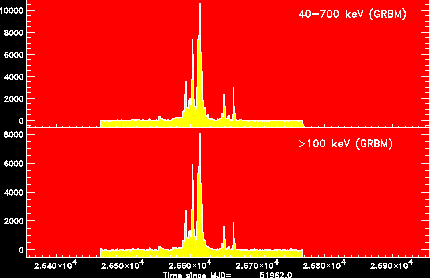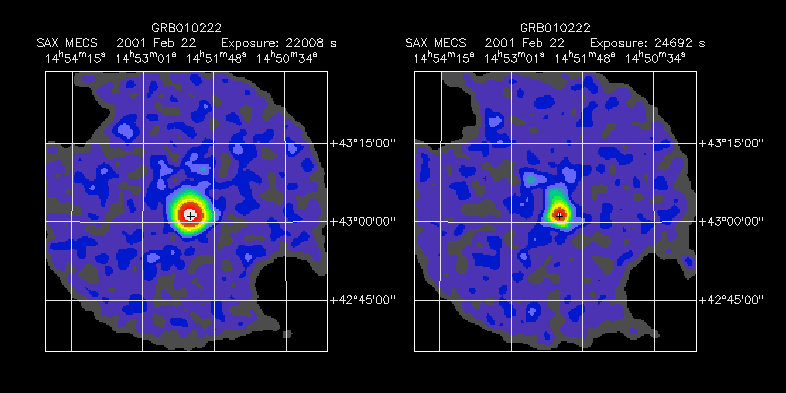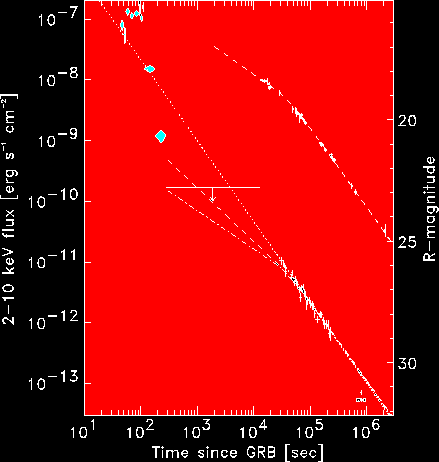
The bright gamma-ray burst of February 22, 2001
Follows a quick reference guide for BeppoSAX measurements on GRB010222. The full
details are accessible through a
preprint of a paper accepted by ApJ on June 6, 2001. The X-ray afterglow
data are available for public use at this anonymous ftp site.
On February 22, 2001, at 7:23 Universal Time,
BeppoSAX
instruments detected for the 45th time a
gamma-ray burst: GRB010222. This burst is one of the brightest
discovered thus far with BeppoSAX, and also one of the longest with a duration of
about 5 minutes. The fluences and fluxes are ranked as follows within the set of
BeppoSAX bursts:
| Rankings in gamma-rays: | #3 in peak flux after GRB000210 and GRB990123 | 8.6X10-6 erg s-1cm-2 |
| | #2 in fluence after GRB990123 | 9.3X10-5 erg cm-2 |
| Rankings in X-rays: | #2 in peak flux after GRB990712 | 2.1X10-7 erg s-1cm-2 |
| | #1 in fluence | 1.0X10-5 erg cm-2 |

Signal strength of GRB010222 as a function of time during the first minutes
in BeppoSAX's Gamma-Ray Burst Monitor
The Wide Field Cameras on
BeppoSAX were used to quickly determine a 2.5 arcminute position of GRB010222. This
position was distributed in the scientific community 3.2 hours after the
burst. Within an hour, the optical afterglow was indentified in the WFC error box by Henden
and collaborators at the US Naval Observatory,
and within 8 hours the distance
to this object was published by Garnavich et al. of Harvard-Smithsonian
Center for Astrophysics and collaborators,
as 3.5 billion light years.

This image is a composite
made by Barbara Mochejska of CCD images collected at the F. L. Whipple Observatory 1.2-meter
telescope by J. McDowell
and R. Kilgard. The size is 5 arcmin by 5 arcmin.
Because of its brightness, a major effort was initiated by scientists
to study this gamma-ray burst in great detail at radio, optical and
X-ray wavelengths, using state-of-the-art telescopes such as the narrow-field instruments
on BeppoSAX, the
Very Large Array of radio telescopes in New Mexico,
the Hubble Space
Telescope and the Chandra X-ray Observatory.
Follows an image of the X-ray afterglow as observed with
BeppoSAX.

Two sequential frames taken
with the Medium-Energy Concentrator Spectrometer on BeppoSAX that show a bright and fading
X-ray afterglow. The cross marks the position of the optical counterpart (at
8 arcsec from the X-ray centroid).
Follows the afterglow light curve, in the optical R-band (top right) and in 2-10
keV X-rays (from WFC and NFI data). In the bottom right-hand corner is a data
point from Chandra X-ray Observatory observations (Harrison et al. 2001). There
is an achromatic break at an early 0.5 days after the GRB event. This may be
interpreted as due to a quick break in a dense circumburst medium. The earliest
NFI data point is at 8 hours after the GRB at 1.2X10-11 erg s-1
cm-2 which is the brightest of all GRB afterglows except one (GRB991216).

Optical and X-ray light curves of the afterglow.
Papers on GRB010222 submitted to refereed journals:
- Frail et al.:
"GRB 010222: A Burst Within a Starburst",
submitted August 28, 2001, to ApJ
- Dai & Cheng:
"Afterglow Emission from Highly Collimated Jets with Flat Electron
Spectra: Application to the GRB 010222 Case?",
2001, ApJL, 558, L109
- Cowsik et al.:
"Optical Photometry of the GRB 010222 Afterglow",
2001, Bull. Astron. Soc. India, published
- Stanek et al.:
"Rapid UBVRI Follow-up of the Highly Collimated Optical Afterglow of GRB010222",
2001, ApJL, in press
- Sagar et al.:
" Optical and Radio observations of th bright GRB010222 afterglow: evidence for rapid
synchrotron cooling?", 2001, Bull.
Astron. Soc. India, published
- In 't Zand et al.:
"BeppoSAX measurements of the bright gamma-ray burst 010222",
2001, ApJ, 559, 710
- Masetti et al.:
"GRB010222: afterglow emission in a rapidly decelerating jet",
2001, A&A, 374, 382
- Jha et al.:
"The redshift of the optical transient associated with GRB 010222",
2001, ApJL, 554, L155
For a compilation of over 40 GCN and IAU circulars, see
Jochen Greiner's page on GRB010222.
Links to other web pages on GRB 010222:
Jean in 't Zand, SRON, November 15,
2001




